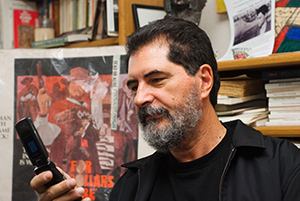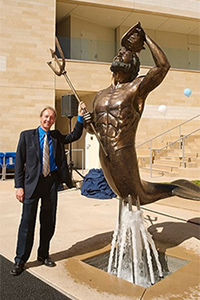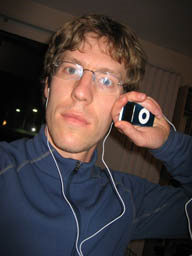Going Social: Faculty, Administrators
and Departments Try New Ways to Reach Out to Students
Roxana Popescu | November 9, 2009
Sitting in his office in the Literature Building, Pasquale Verdicchio looks every bit the literary scholar — probing eyes gleam through reading glasses, a salt-and-pepper beard whispers authority, while a silver cuff adds a dash of the boheme. Naturally, there are books everywhere. Books stacked on the ground, books piled on his desk, books lining the walls. But on closer inspection, there’s something that complicates his professorial persona: an iPod touch, which lets him stay connected 24/7 and which he pronounced in a recent email message “quite a wonderful gadget!!!”

Pasquale Verdicchio, associate professor of Italian and comparative literature.
Verdicchio, it turns out, is a social media fiend. He knows text speak and he’s not afraid to use it. He’s been blogging ever since that word was a verb. He migrated to Facebook years ago and has used it to communicate with students in two of his classes.
For a man who has 17 blogs, the value of using social media to reach out to students is logistical and, in a sense, psychological. “It brings you closer to the students’ frame of mind. They’re born in it and they probably can’t remember a time without it,” he says.
Today’s undergraduates, who are at the tail end of Generation Y, have been on Facebook, Myspace and other social networking sites for more than half a decade (not to mention a quarter of their lives, give or take). Meanwhile, universities have been using computers and the Internet as teaching tools for at least as long. While social media is only now starting to tiptoe into the classroom, professors and administrators at UCSD exploring this uncharted territory are obtaining some rewarding—and sometimes surprising—results. As their online presence gains traction, what these users must still determine is how to best utilize these resources and what degree of contact students are most comfortable with.
Gary Ratcliff, assistant vice chancellor for student life, says Facebook and its peers—Twitter, blogging and other interactive platforms—are quickly becoming an imperative.

Gary Ratcliff, assistant vice chancellor for Student Life, poses with the Triton statue.
“We are seeing more departments having a presence, and I am seeing more of my staff having a presence on there. Because students want to communicate with us that way,” Ratcliff says, adding his department has been using Facebook for about two years. Now when his staff members decide how to market an event or program, “Facebook is always part of that plan,” he says.
For Corie Gochicoa, student affairs coordinator for the Linguistics Department, the impact of her department’s presence on Facebook has been surprising. She set up a Facebook fan page at the start of the quarter and emailed students and alumni about it. The response was instant. The page attracted 106 fans within a month.
Most interesting, she says, has been the response from alumni. More than half of the department’s fans are alums, who post updates and keep in touch. Gochicoa also uses the site to publicize events, which is typical for many types of organizations using Facebook.
“We try sending out emails, but people get so inundated with emails that they don’t read them. This gives us another way to communicate with them.” But, she adds, “Now they may be getting inundated on Facebook, too.”
Ratcliff added that social media is one resource out of many he uses to get the word out about events or solicit feedback from students. “Facebook is just one method. There are many other methods,” he says. “We wouldn’t put all our eggs into one basket.”
If Facebook is about establishing and maintaining relationships, Twitter’s 140-character limit makes it perfect for quick informational dispatches. That makes it a useful tool for campus-wide departments, libraries and anyone who has logistical issues to tell people about. Sample tweet from the @ucsdshuttles account: “Coaster Shuttles delayed due to traffic accident on both NB and SB I-5.” And from the Biomedical Library, which has more than 200 followers: “The bad news: printing is really messed up.”
Since it’s hard to measure the effectiveness of social media by any concrete metrics, effective campaigns should spread out over multiple platforms, experts say.
That’s been the approach of the Jacobs School of Engineering, which has a blog, a Twitter account, a YouTube presence and a Facebook page for alumni. Each has a different role, but together these facets help humanize the highly technical school and let it display material in a very quick and friendly fashion.

Daniel Kane
“There’s so much going on at the Jacobs School that with the Internet people can very quickly get a glimpse of what’s happening at the school,” says Daniel Kane, a public information officer for the school who is on the team that executes its social media campaign.
The Twitter account, for example, is replete with links to news releases about recent research findings. The blog focuses on people in the school, showcasing items like the geeky pumpkins students carved for Halloween. And the YouTube videos showcase a canoe competition, interviews with researchers and approachable insights into current research.
Kane says that while students aren’t commenting on the sites, they do sometimes send emails. Also, the blog’s traffic log shows people searching for students’ names, suggesting students are telling their friends and families to look them up.
The approach isn’t that different from traditional outreach.
“The principles are the same, but this gives us more tools, and it lets us be a little bit more targeted with our audiences, and a little bit more personal, which I think people appreciate,” Kane says.
So these days, if you are a first year bioengineering student, you can get to know your colleagues outside the classroom, thanks to the cohort’s Facebook page. If you want to leave feedback about campus happenings, you can always comment at the fan page of AS Concerts and Events. And if you’re a student in the Literature Department you can learn about cool events on Twitter (Sushi Performance and Visual Art, anyone?) or kvetch about exams on Facebook. (“oh my god, is anyone else having trouble setting up the oral exam time? this is turning out o be a NIGHTMARE for me.”)
While some students are jumping at the chance to stay in contact with administrators or departments or showcase their achievements online, others are more wary. Connecting with a faculty member might strike some as odd. (“That would be so weird. I would never, ever friend a professor on Facebook,” said one senior). But even the more impersonal encounters—like classroom group pages or collective blogs—remain fraught with uncertainties. How much access does the professor have to a person’s online profile? How often should a student contribute and how does that factor into the grade, if at all?
Jan Ba, a student who took the engineering course “Applied Innovations” last year, set up a Facebook page hoping his classmates would start trading ideas about projects. He thought it would be a surefire method, since everyone already had Facebook accounts. Only a dozen participated.
“It helped a little to get an overview in the beginning but this overview was not complete since not everyone joined,” he wrote in an interview conducted over—what else—Facebook.
Verdicchio, of the Literature Department, has been using blogs and Facebook to get the word out about ideas, interpretations, and assignments. “That makes it real for them—because it’s not in a medium and format that might appear foreign,” he says.
But there, too, student reactions pages have been few and far between, making him wonder: Has he adopted the right approach? Is it that students are already bombarded by social media and don’t want to participate in yet another conversation? Or is it that his sites are associated with schoolwork, hence unattractive?
Verdicchio admits he could get by just fine without social media as a didactic tool (and even better without students constantly tinkering with their iPhones and laptops during class). He still edits his scholarly texts by hand and enjoys reading, well, real books.
What he wishes for is someone talking back. One of his blogs, online at http://environmondo.blogspot.com, used for his Environmental Literatures and Wilderness Thought course, included the syllabus, assignments, but also relevant articles and reflections. And almost no comments. One quote he posted, from Thai Buddhist teacher Ajahn Sumedho, seems ideal for launching a heated discussion: “We say this thing is good or it’s bad, but in itself, the thing is only as it is. It’s not absolute; it’s just as it is. People are just as they are.”
Verdicchio might get an answer soon, thanks to a study underway now. James Fowler, an associate professor of political science at UCSD and an expert in social networks, is about to track the Facebook patterns of 1,000 undergraduates at UCSD to understand how they use the site and how their online and offline networks compare. Whether or not students are interested in using social media as a classroom tool — at last faculty and administrators may have a better understanding why.

|